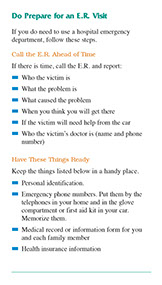CONDITIONS
SYMPTOM CHECKER
Male
Female
Child
Arm, Hand & Shoulder Concerns
Legs & Feet Concerns
Dental & Mouth Concerns
Ear & Nose
Eye Conditions
Head Conditions
Arm, Hand & Shoulder Concerns
Legs & Feet Concerns
Front
Back
Arm, Hand & Shoulder Concerns
Dental & Mouth Concerns
Ear & Nose
Eye Conditions
Head Conditions
Arm, Hand & Shoulder Concerns
Dental & Mouth Concerns
Ear & Nose
Eye Conditions
Head Conditions
Front
Back
Arm, Hand & Shoulder Concerns
Neck Links
Head & Neck Concerns
Arm, Hand & Shoulder Concerns
Neck Links
Head & Neck Concerns
Front
Back
Online Clinic
Wise Healthcare
How to Use the Emergency Department
Print on Demand
Do Prepare for an E.R. Visit
If you do need to use a hospital emergency department, follow these steps.
Call the E.R. Ahead of Time
If there is time, call the E.R. and report:
• Who the victim is
• What the problem is
• What caused the problem
• When you think you will get there
• If the victim will need help from the car
• Who the victim’s doctor is (name and phone number)
Have These Things Ready
Keep the things listed below in a handy place.
• Personal identification.
• Emergency phone numbers. Put them by the telephones in your home and in the glove compartment or first aid kit in your car. Memorize them.
• Medical record or information form for you and each family member
• Health insurance information
• Consent form or letter written by you to allow your child to get medical, surgical, and/or emergency treatment. Ask your child’s doctor where you can get a consent form or what to put in a letter. Make sure you sign this form or letter. You can get copies of “Medical Consent to Treat Form,” “Emergency Information Form for Children with Special Health Care Needs,” and “Personal Medical History” from the American Academy of Emergency Physicians’ Web site: www.acep.org or by calling 800.798.1822.
• Phone numbers where you can be reached when someone cares for your children
{Note: Let others who take care of your children know where these things are.}
People with specific medical conditions and severe allergies should wear a medical alert tag (e.g., bracelet, neck chain.) This helps a rescuer know what special precautions may need to be taken. You can buy these tags at many drug stores or order one from Medic Alert Foundation International at 888.633.4298 or www.medicalert.org.
Do Take a Companion to the E.R.
When you need emergency medical care, it’s a good idea to have a relative or friend go with you. He or she can do the following:
• Get you registered
• Answer questions for you if you can’t answer them yourself
• Speak on your behalf and in your best interest. {Note: If you have an advance directive - Durable Power of Attorney for Health Care, take a copy with you to the hospital. Let your relative or friend know if you have this and how it can be obtained (e.g., your lawyer’s or doctor’s phone number). If you do not have this advance directive, let your relative or friend know.}
• Serve as a “clear head” to monitor the procedures being done
• Check out what kind of service you’re getting
• Be available in the waiting area
• Take you home
Do Know What to Expect at the E.R.
Triage
• A triage nurse evaluates your condition. He or she ranks all the patients in 3 general categories:
– Life-threatening
– Urgent, but not life-threatening
– Less urgent
• You need to describe the problem and the steps that led to it. (You may have to tell this to other people as well.)
• The seriousness of your condition and of other people at the E.R. will determine how soon you are seen.
Registration
• You are asked for personal and insurance information. A family member or friend may provide this information while you are in triage.
• A medical record is set up for your visit. If the problem is life-threatening, this step would be completed later.
Waiting Room
• You’ll probably have to wait to be seen. How long you wait will depend on the number of people to be seen and where you rank on the triage list. Other people may come in with a more serious condition than yours while you are waiting. This can cause you to wait even longer.
• Let the triage nurse know if you feel worse while you are waiting.
• Don’t eat or drink anything or take any medication until you are seen by the doctor (unless the triage nurse tells you it is okay).
Examination Room
• Here you are first seen by a nurse who gets more information to help diagnose your problem. This includes asking questions, taking your temperature, etc.
• While you are in the examination room, the nurse consults with the physician in the E.R.
• You are then seen by a physician who gets a more detailed medical history and examines you.
Diagnosis and Treatment
• The doctor makes an initial diagnosis.
• The doctor may order blood tests, X-rays, etc.
• When a final diagnosis is made, treatment is prescribed or provided.
Outcome
Depending upon the diagnosis and treatment, you are either discharged, admitted to the hospital, or moved to a facility that is better equipped to treat the problem.
What to Do When You Are Discharged
• Make sure you get a written list of things you are to do after you leave. Read the list before you leave. Make sure you understand what you are supposed to do.
• Before you leave, find out where you can get a prescription filled or any other supplies you need (i.e., 24 hour pharmacy).
• Ask the following questions:
– What follow-up care is needed?
– What is the name of the E.R. doctor who treated you?
– Are there special considerations for the next 24 to 48 hours?
– Should you contact your own doctor and how soon?
• Have someone else drive you home.
• Call your doctor and/or the E.R. when you are told to do so. It could be to report:
– What has happened
– How you are doing
– If you are getting worse
– If you have more problems
This website is not meant to substitute for expert medical advice or treatment. Follow your doctor’s or health care provider’s advice if it differs from what is given in this guide.
The American Institute for Preventive Medicine (AIPM) is not responsible for the availability or content of external sites, nor does AIPM endorse them. Also, it is the responsibility of the user to examine the copyright and licensing restrictions of external pages and to secure all necessary permission.
The content on this website is proprietary. You may not modify, copy, reproduce, republish, upload, post, transmit, or distribute, in any manner, the material on the website without the written permission of AIPM.
2021 © American Institute for Preventive Medicine - All Rights Reserved. Disclaimer | www.HealthyLife.com

















































